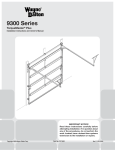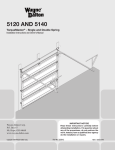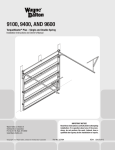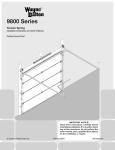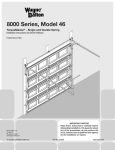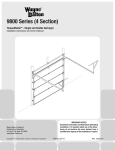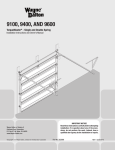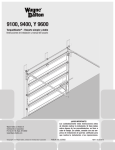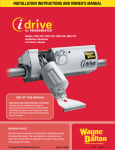Download Wayne-Dalton TORQUEMASTER 5140 Owner`s manual
Transcript
Tools Needed: None Shake the TorqueMaster® spring tube gently to extend the winding shafts out about 5" on each side. For single spring applications, there will be no left hand spring in the TorqueMaster® spring tube. WINDING SHAFT SPLINES RIGHT HAND CABLE DRUM FLAGANGLE Lift the TorqueMaster® spring tube and rest it on the top of the flagangles. Orient TorqueMaster® spring tube so that back of opener is flat against header/mounting surface. CABLE DRUM NOTE: Cable drums are marked right and left hand. Cable drums and TorqueMaster® spring tube are cam shaped to fit together only one way. To install the cable drum, slide the correct cable drum over the winding shaft until the cable drum seats against the TorqueMaster® spring tube. The winding shaft must extend past the cable drum far enough to expose the splines and the groove. Align the winding shaft groove with the round notch in the flagangle. COUNTERBALANCE CABLE GROOVE WINDING SHAFT GROOVE TORQUEMASTER® SPRING TUBE ROUND NOTCH FLAGANGLE For Double Spring Applications: Repeat for opposite side. For Single Spring Applications: Insert the loose winding shaft into the left hand cable drum prior to sliding the cable drum over the TorqueMaster® spring tube. NOTE: On single spring applications, take care in handling the loose winding shaft (left side) so that it does not slide back into the TorqueMaster® spring tube. ROUND NOTCH WINDING SHAFT ® TORQUEMASTER SPRING TUBE CABLE DRUM Left Hand Side Single Spring Application GROOVE ROUND NOTCH LEFT HAND CABLE DRUM TORQUEMASTER® SPRING TUBE LOOSE WINDING SHAFT Please Do Not Return This Product To The Store. Call Us Directly! Our Trained Technicians Will Answer Your Questions and/or Ship Any Parts You May Need. You can reach us Toll Free at 1-888-827-3667 for Consumer Assistance or online at www.wayne-dalton.com 21 INSTALLATION 18 Cable Drum Installation TORQUEMASTER® SPRING TUBE 19 Tools Needed: None Drive Gear Installation CABLE DRUM Beginning with the right hand side, lubricate entire circumference of the 36 tooth worm gear with the lubricating oil provided. Slide the 36 tooth worm gear onto the winding shaft splines until it touches the flagangle. NOTE: On single spring applications, no 36 tooth worm gear is required on the left side. WINDING SHAFT SPLINES LUBRICATING OIL 36 TOOTH WORM GEAR FLAGANGLE NOTE: If additional lubricating oil is needed, use “Dura Lube® Engine Oil Treatment”. CABLE DRUM 36 TOOTH WORM GEAR WINDING SHAFT 20 Tools Needed: None End Brackets END BRACKET IMPORTANT: WARNING TAGS MUST BE SECURELY ATTACHED TO BOTH END BRACKETS. WARNING TAG Slide the right hand end bracket over the drive gear and fasten to the flagangle using a #10 self-tapping screw. Drill 3/16” pilot holes into jamb for the lag screws. Secure end bracket and the flagangle to the jamb using (2) 5/16” x 1-5/8" lag screws. Repeat for left hand side. (2) 5/16” X 1-5/8” LAG SCREWS #10 PHILLIPS HEAD SCREW 22 Please Do Not Return This Product To The Store. Call Us Directly! Our Trained Technicians Will Answer Your Questions and/or Ship Any Parts You May Need. You can reach us Toll Free at 1-888-827-3667 for Consumer Assistance or online at www.wayne-dalton.com 21 Tools Needed: None WINDING SHAFT INSIDE END BRACKET Counter Installation COUNTER GEAR Install the right side counter gear, with the missing tooth toward the outside and away from the end bracket. Press the counter gear onto the end bracket until snaps engage. Select the right hand counter cover and align the hex of the counter cam with the end of the winding shaft. Also, align the “0” on the counter cover with the raised rib on the end bracket. Press the counter cover against the counter gear until it locks into place. MISSING TOOTH RAISED RIB “0” COUNTER COVER HEX OF THE COUNTER CAM Repeat for left hand side for double spring applications. INSTALLATION NOTE: No 36 tooth worm gear, counter gear or counter cover is required on left hand side for single spring applications. Only an end bracket is needed. IMPORTANT: AT THIS TIME DO NOT WIND COUNTERBALANCE SPRINGS! 22 Tools Needed: Power Drill Securing Center Bracket Assembly NOTE: If you are installing an idrive® opener on your garage door, skip this step and continue with Step 23. CENTER BRACKET BUSHING ASSEMBLY 1/8” Drill Bit 7/16” Socket Driver NOTE: If you are not installing an idrive® opener on your garage door, you must install the center bracket bushing assembly. Follow these instructions for non-idrive® operated garage doors. NOTE: If you are installing a DoorMaster™ opener, see optional DoorMaster™ Bracket installations on page 32, Figure B. To locate the center bracket, mark the header halfway between the flagangles and level the TorqueMaster® spring tube. Drill 1/8” pilot holes into header for the lag screws. Fasten the metal bracket to the header using (2) 5/16” X 1-5/8” lag screws. (2) 5/16” X 1-5/8” HEX HEAD LAG SCREWS NOTE: Upon completion of this step, continue with Step 27. Please Do Not Return This Product To The Store. Call Us Directly! Our Trained Technicians Will Answer Your Questions and/or Ship Any Parts You May Need. You can reach us Toll Free at 1-888-827-3667 for Consumer Assistance or online at www.wayne-dalton.com 23 23 Positioning Support Bracket Tools Needed: NOTE: See idrive® main installation and owners manual for idrive® parts. TORQUEMASTER® SPRING TUBE 45 ANGLE ANTENNA WIRE MOUNTING SURFACE Power Drill 1/8” Drill Bit 7/16” Socket Driver NOTE: idrive® must be installed on a solid mounting surface. Locate the mounting surface. Remove (2) 1/4”-20 flange nuts from bottom of opener. NOTE: Do not discard flange nuts. Place the support bracket underneath opener, to the right side of motor, centered on mounting surface. Using a tape measure, level the bottom of the TorqueMaster® spring tube to the top of the door section with the idrive® resting on the support bracket. Once TorqueMaster® spring tube is level, drill 1/8” pilot holes for the lag screws. Then secure support bracket to the mounting surface with (2) 1/4” x 1-1/2" lag screws. 1/4” X 1-1/2” LAG SCREWS (HEADER) 1/4” - 20 FLANGE NUTS TOP OF DOOR MOUNTING STUDS IMPORTANT: TORQUEMASTER® SPRING TUBE MUST BE LEVEL AFTER SUPPORT BRACKET IS FASTENED TO MOUNTING SURFACE. NOTE: If wood mounting surface is behind dry wall, use 1/4” x 2” lag screws. Lift and slide the opener over the support bracket, aligning the mounting studs with the bracket slots. Loosely fasten to mounting studs with the (2) 1/4”-20 flange nuts. SUPPORT BRACKET MOUNTING STUDS SUPPORT BRACKET TORQUEMASTER® SPRING TUBE NOTE: Do not tighten 1/4”-20 flange nuts to opener studs at this time. You will be instructed when to tighten them in the idrive® main installation and owners manual. Remove the temporary orange label holding the antenna wire. Straighten antenna wire and angle it 45 degrees to the right. NOTE: Do not coil the antenna wire. This will reduce the radio signal range. BRACKET SLOTS (2) 1/4” - 20 FLANGE NUTS “X” “X” “X” TOP SECTION USING A TAPE MEASURE, MAINTAIN AN EQUAL MEASUREMENT “X” (TOP OF DOOR TO BOTTOM OF TORQUEMASTER® TUBE) AT BOTH ENDS AND THE CENTER. 24 Please Do Not Return This Product To The Store. Call Us Directly! Our Trained Technicians Will Answer Your Questions and/or Ship Any Parts You May Need. You can reach us Toll Free at 1-888-827-3667 for Consumer Assistance or online at www.wayne-dalton.com 24 Tools Needed: Pliers Attaching Disconnect Cables S-HOOK NOTE: See idrive® main installation and owners manual for idrive® parts. DISCONNECT CABLE HOLE IN RIGHT END BRACKET Attach the loose disconnect cable (located in opener hardware bag) to the opener with the “S” hook. Close both ends of the “S” hook (with pliers) to lock assembly together. Thread the disconnect cable (behind the counterbalance cable) through the hole in the right hand end bracket; remove all slack between opener and right end bracket. RIGHT SIDE OF END BRACKET CLOSE “S” HOOK 25 Tools Needed: Pencil Tape measure 1/8” Drill Bit 7/16” Socket Driver INSTALLATION HOLE IN END BRACKET Mounting Disconnect Handle Bracket NOTE: See idrive® main installation and owners manual for idrive® parts. Mark a location on the right jamb, 6 feet above the floor to mount the disconnect handle bracket. Drill 1/8” pilot holes for the lag screws. Power Drill Align top of the bracket with the mark. Fasten bracket to the jamb with (2) 1/4” x 1-1/2" lag screws. 6ft (2) 1/4” X 1-1/2” LAG SCREWS DISCONNECT HANDLE BRACKET Please Do Not Return This Product To The Store. Call Us Directly! Our Trained Technicians Will Answer Your Questions and/or Ship Any Parts You May Need. You can reach us Toll Free at 1-888-827-3667 for Consumer Assistance or online at www.wayne-dalton.com 25 26 Tools Needed: Phillips head screwdriver Wire cutters Attaching Disconnect Handle NOTE: See idrive® main installation and owners manual for idrive® parts. NOTE: Bring motor to the down position by pulling the disconnect cable, insure opener disconnect teeth are engaged before installing disconnect handle. Start the #6-20 x 1/2" screw into the disconnect handle. Thread the disconnect cable through the top of the disconnect handle bracket and then the disconnect handle. UPPER POSITION #6-20 X 1/2” SCREW HANDLE Locate the disconnect handle in full upper position of disconnect handle bracket. Remove all disconnect cable slack between the opener and the top of the disconnect handle bracket. Tighten #6-20 x 1/2" screw into the disconnect handle until snug, and then tighten screw an additional 1 to 1-1/2 turns to secure disconnect cable to the disconnect handle. Trim off excess cable from bottom of the disconnect handle. DISCONNECT CABLE EMERGENCY DISCONNECT LABEL DISCONNECT HANDLE BRACKET MANUAL OPERATED POSITION MOTOR OPERATED POSITION CAUTION: PULL CABLE ONLY TAUT ENOUGH TO REMOVE THE CABLE SLACK. PULLING THE CABLE MORE COULD CAUSE OPENER TO DISCONNECT FROM THE TORQUEMASTER® SPRING TUBE. Apply emergency disconnect label next to the mounted bracket. Use mechanical fasteners if adhesive will not adhere. Using the emergency disconnect, pull disconnect handle downwards and place it in the manual door operated position (Use disconnect label for reference). Motor will be rotated 90° from its packaged position. If motor does not pivot 90°, see troubleshooting section in the main installation and owners manual of your idrive® opener 26 Please Do Not Return This Product To The Store. Call Us Directly! Our Trained Technicians Will Answer Your Questions and/or Ship Any Parts You May Need. You can reach us Toll Free at 1-888-827-3667 for Consumer Assistance or online at www.wayne-dalton.com 27 Tools Needed: Vice Clamp Securing Door for Spring Winding Place vice clamps onto both vertical tracks just above the third roller. This is to prevent the garage door from raising while winding counterbalance springs. WARNING FAILURE TO PLACE VICE CLAMPS ONTO VERTICAL TRACK CAN ALLOW DOOR TO RAISE AND CAUSE SEVERE OR FATAL INJURY. PLACE VICE CLAMPS ABOVE 3RD ROLLER IMPORTANT: DO NOT USE IMPACT GUN TO WIND SPRING(S). 28 Tools Needed: Locking Pliers Flat Tip Screwdriver TRACK INSTALLATION VICE CLAMPS ATTACHED TO INNER RAIL OF TRACK Cable Adjustments Rotate the cable drum until the set screw faces directly away from the header. TorqueMaster® spring tube cam peak should be pointing straight up. COUNTERBALANCE CABLE CABLE DRUM CAM PEAK STRAIGHT UP Beginning with the right side, loosen the set screw approximately 2 turns, to adjust cable. Using locking pliers, pull on the end of the cable to remove all cable slack. Check to ensure the cable is aligned and seated in the first groove of the cable drum. Snug the set screw, then tighten an additional 1-1/2 turns. Cut excess cable. SET SCREW Please Do Not Return This Product To The Store. Call Us Directly! Our Trained Technicians Will Answer Your Questions and/or Ship Any Parts You May Need. You can reach us Toll Free at 1-888-827-3667 for Consumer Assistance or online at www.wayne-dalton.com 27 29 Tools Needed: Power Drill 7/16" Socket Driver Winding Bolt Rotation See chart in Step 30 for proper spring tension setting. WINDING BOLT Beginning with the right hand side, ensure the cable is in the first groove of the cable drum. Apply light pressure to the canoe clip on counter cover while winding springs. Using a power drill (high torque/gear reduced to 1300 RPM preferred) with a 7/16" socket, carefully rotate right hand winding bolt clockwise, until counter shows 2-3 turns. CANOE CLIP This will keep the counterbalance cable taut while adjusting the left hand side counterbalance cable. Adjust left hand counterbalance cable tension. (refer to Step 28) NOTE: Single spring applications require no spring winding on left hand side, but need cable tension adjusted. NOTE: Ensure counterbalance cable tension is equal for both sides prior to fully winding spring(s) to appropriate number of turns. If cable tension is unequal refer to Step 28. 30 Tools Needed: Power Drill 7/16” Socket Driver 7/16" Wrench 28 Setting Spring Tension NOTE: Apply light pressure to the canoe clip on the counter cover while winding spring(s). See the Spring Turn chart. For SINGLE SPRING applications, return to the right hand side and carefully rotate the winding bolt head clockwise until the counter shows the correct number of turns for your door. For DOUBLE SPRING applications, remain on the left hand side and carefully rotate the winding bolt head clockwise until the counter shows the correct number of turns for your door. Then return to the right hand side and wind the right hand spring to the required number of turns. IMPORTANT: DO NOT OVERWIND. After spring is wound, hold the lock nut (in back of end bracket) stationary on the right hand side with a 7/16” wrench while rotating the winding bolt clockwise until snug. Tightening of the lock nut prevents spring from unwinding. Repeat for opposite side for double spring TorqueMaster® systems. IMPORTANT: CAUTIOUSLY REMOVE VICE CLAMPS FROM VERTICAL TRACKS. ADJUSTMENTS TO THE RECOMMENDED NUMBER OF TURNS MAY BE REQUIRED. AFTER REAR SUPPORT ASSEMBLY IS COMPLETE (STEP 32), CHECK DOOR BALANCE. IF DOOR RAISES OFF FLOOR UNDER SPRING TENSION ALONE, REDUCE SPRING TENSION UNTIL DOOR RESTS ON THE FLOOR. IF THE DOOR IS HARD TO RAISE OR DRIFTS DOWN ON ITS OWN, ADD SPRING TENSION. AN UNBALANCED DOOR SUCH AS THIS CAN CAUSE IDRIVE® OPERATION PROBLEMS. 15 .5 SPRING TENSION SAMPLE SETTING LOCK NUT 7/16” WRENCH NOTE: For 7’ high doors, 8’, 9’, 10’, 16’ or 18’ wide with windows, the recommended number of spring turns is 15. RECOMMENDED SPRING TURNS Door Height idrive® Operated Doors 11’-11” Wide or Less Manually Operated Door, and idrive® Operated Doors 12’ Wide or Greater 7’-0” 15-1/2 16 8’-0” 17-1/2 18 Please Do Not Return This Product To The Store. Call Us Directly! Our Trained Technicians Will Answer Your Questions and/or Ship Any Parts You May Need. You can reach us Toll Free at 1-888-827-3667 for Consumer Assistance or online at www.wayne-dalton.com 31 Tools Needed: None DRUM WRAP Drum Wrap Installation Drum wraps are identified as right and left hand. OUTSIDE FLANGE To install, place the drum wrap over the cable drum and under the idrive® disconnect cable (right hand side). Align the outside flange over the outside edge of the cable drum and push the drum wrap down onto the cable drum. Repeat for left hand side. CABLE DRUM NOTE: Drum wraps must be installed to prevent cable from becoming tangled. INSTALLATION IMPORTANT: RIGHT AND LEFT HAND ARE ALWAYS DETERMINED FROM INSIDE THE BUILDING LOOKING OUT. CABLE DRUM DRUM WRAP 32 Tools Needed: Ratchet Wrench 1/2” Socket 1/2” Wrench (2) Vice Clamps Tape Measure Level Hammer Rear Support WARNING DOOR IN THE UP POSITION KEEP HORIZONTAL TRACK PARALLEL AND WITHIN 3/4” MAXIMUM OF DOOR EDGE, OTHERWISE DOOR COULD FALL, RESULTING IN SEVERE INJURY OR DEATH. Raise the door until the top section and half of the next section are in a horizontal position. Do not raise door any further since the horizontal tracks are not yet supported at the rear. WARNING 3/4” VICE CLAMPS DOOR EDGE RAISING DOOR FURTHER CAN RESULT IN DOOR FALLING AND CAUSE SEVERE INJURY OR DEATH. Clamp a pair of vice clamps on the vertical tracks just above the second roller on one side, just below the second roller on the other side. This will prevent the door from raising or lowering while installing the rear support. VERTICAL TRACK HORIZONTAL TRACK Please Do Not Return This Product To The Store. Call Us Directly! Our Trained Technicians Will Answer Your Questions and/or Ship Any Parts You May Need. You can reach us Toll Free at 1-888-827-3667 for Consumer Assistance or online at www.wayne-dalton.com 29 32 Tools Needed: Rear Support - Continued SOUND FRAMING MEMBERS Using perforated angle, 5/16” x 1 5/8” hex head lag screws and 5/16” bolts with nuts (may not be supplied), fabricate rear support for horizontal tracks. Attach horizontal tracks to the rear supports with 5/16”-18 x 1-1/4” hex bolts and nuts (may not be supplied). Horizontal tracks must be level and parallel with door. NOTE: If rear supports are to be installed over drywall, use 5/16” x 2” hex head lag screws. NOTE: If an idrive® opener will be installed, position horizontal tracks one hole above level when securing it to rear supports. Adjust weather seal (if necessary). Permanently attach the weather seal to both door jambs and header. (Temporarily attached in PREPARING THE OPENING on page 10.) Avoid pushing weather seal too tightly against face of door. Now, lift door and check it’s balance. Adjust, if door lifts by itself (hard to pull down) or if door is difficult to lift (easy to pull down). Anytime spring adjustments are made you must loosen the lock nuts and retighten both lock nuts afterwards. To adjust spring(s), only add or remove 1/4 turn on the counter at a time. Adjust both sides equally. PERFORATED ANGLE BOLTED USING (2) 5/16” X 1-5/8” HEX HEAD LAG SCREWS TO CEILING MEMBER AND PARALLEL TO DOOR HORIZONTAL TRACK BOLT MUST EXTEND INTO THE TRACK TO SERVE AS A ROLLER STOP PERFORATED ANGLE BRACE SOUND FRAMING MEMBERS PERFORATED ANGLE BRACE HORIZONTAL TRACK PERFORATED ANGLE BOLTED USING (2) 5/16” X 1-5/8” HEX HEAD LAG SCREWS TO CEILING MEMBER AND PARALLEL TO DOOR BOLT MUST EXTEND INTO THE TRACK TO SERVE AS A ROLLER STOP PERFORATED ANGLE IMPORTANT: DO NOT ADD OR REMOVE MORE THAN 1 SPRING TURN FROM SPECIFIED AMOUNT. IF THE DOOR STILL DOES NOT OPERATE EASILY, LOWER THE DOOR INTO THE CLOSED POSITION, UNWIND SPRING(S) TO ZERO, AND RECHECK THE FOLLOWING ITEMS: 1.) Check the door for level. 2.) Check the TorqueMaster® spring tube and flagangles for level and plumb. 3.) Check the distance between the flagangles - must be door width plus 3-3/8” to 3-1/2”. 4.) Check the counterbalance cables for equal tension - adjust if necessary. 5.) Rewind the spring(s). 6.) Make sure door isn’t rubbing on jambs. NOTE: As a safety feature, the right hand end bracket cannot be disassembled for service until the spring is completely unwound and the counter cover reads zero. After door installation is completed, refer to the idrive® owner’s manual. 30 WEATHER SEAL JAMB (3) 5/16” BOLTS & NUTS PERMANENTLY ATTACHED WEATHER SEAL OR DOOR STOP Please Do Not Return This Product To The Store. Call Us Directly! Our Trained Technicians Will Answer Your Questions and/or Ship Any Parts You May Need. You can reach us Toll Free at 1-888-827-3667 for Consumer Assistance or online at www.wayne-dalton.com Tools Needed: Power Drill 7/16” Socket Driver 1/8” Side Lock (Sold Seperately) Install the side lock on the second section of the door. Secure the lock to the section with (4) 1/4”- 20 x 11/16” self drilling screws. Square the lock assembly with the door section and align with the square hole in the vertical track. The side lock should be spaced in approximately 1/8” from the section edge. IMPORTANT: SIDE LOCKS MUST BE REMOVED OR MADE INOPERATIVE IN THE UNLOCKED POSITION IF AN OPERATOR IS INSTALLED ON THE DOOR. INSTALLATION NOTE: After completing this step, continue with Step 8 on page 15. (4) 1/4”- 20 X 11/16” SELF DRILLING SCREWS Tools Needed: None DoorMasterTM Bracket/Gear (Supplied With Doormaster™) A DOORMASTERTM BRACKET/ DRIVE GEAR ASSEMBLY A NOTE: When installing a DoorMasterTM operator use the center bracket and drive gear supplied with your operator (located in DoorMasterTM package). Slide the DoorMasterTM bracket/drive gear assembly onto the TorqueMaster® spring tube, so that the drive gear/center bracket assembly are in the center of the TorqueMaster® spring tube. NOTE: After completing this step, continue with Step 18 on page 22. Tools Needed: B Power Drill To locate the center bracket, mark the header halfway between the flagangles and level the TorqueMaster® spring tube. Drill 1/8” pilot holes into header for the lag screws. Fasten the metal bracket to the header using (2) 1/4” x 1-1/2” lag screws. 1/8” Drill Bit 7/16” Socket Driver NOTE: After completing this step, continue with Step 27 on page 28. TORQUEMASTER® TUBE B CENTER BRACKET BUSHING ASSEMBLY (2) 1/4” X 1-1/2” HEX HEAD LAG SCREWS Please Do Not Return This Product To The Store. Call Us Directly! Our Trained Technicians Will Answer Your Questions and/or Ship Any Parts You May Need. You can reach us Toll Free at 1-888-827-3667 for Consumer Assistance or online at www.wayne-dalton.com 31 Tools Needed: 7/16” Drill Bit Power Drill 7/16" Wrench STEP PLATE OUTSIDE Step Plate (Sold Seperately) Make one mark 1” (25 mm) up from the center of bottom edge of the bottom section and another mark 2-3/16” (56 mm) up from the first mark. Drill a 7/16” (11 mm) hole through the section at each mark and insert the outside step plate. Loosely fasten step plate slide to base with (1) 1/4” - 20 x 5/8” carriage bolt and nut. Align inside step plate holes and fasten from inside using the #8 screws provided. Install one #8 x 3/4” screw in the bottom step plate hole. The screw in the top hole varies with door models. 1/4” - 20 X 5/8” CARRIAGE BOLT STEP PLATE BASE STEP PLATE INSIDE ASSEMBLED STEP PLATE (2) #8 SCREWS Use the screw size shown below for your model door. a) #8 x 3/4” screw for Model 5120 b) #8 x 1” screw for Model 5140 Tighten 1/4” - 20 carriage bolt and nut. Tools Needed: Power Drill 1/8” Drill Bit STEP PLATE SLIDE HEX NUT NO. 6 SCEW EYE Pull Rope WARNING DO NOT INSTALL PULL ROPES ON DOORS WITH ELECTRIC OPERATORS. CHILDREN MAY BECOME ENTANGLED IN THE ROPE CAUSING SEVERE OR FATAL INJURY. PULL ROPE Measure and mark the jamb approximately 48” to 50” (1220 to 1270 mm) from floor on the right or left side of door. Drill 1/8” pilot hole for No. 6 screw eye. Tie the pull rope to the No. 6 screw eye and to the bottom bracket as shown. BOTTOM BRACKET PULL ROPE 32 Please Do Not Return This Product To The Store. Call Us Directly! Our Trained Technicians Will Answer Your Questions and/or Ship Any Parts You May Need. You can reach us Toll Free at 1-888-827-3667 for Consumer Assistance or online at www.wayne-dalton.com Measure the curved ends of the horizontal track to determine if you have a 12” or 15” radius horizontal track, as shown in FIG. 2.1. Determine center line of door. Mark vertical line at this point, on the header wall. Raise the door slightly until the top section reaches the highest point of travel (high arc). Using a level, mark this high arc point of travel on the header wall, intersecting the vertical center line, as shown in FIG. 2.2 through 2.3. Hold the wall bracket’s bottom edge to the appropriate 1/2” - 1” (room permitting) above of the high arc line and centered on the vertical line, as shown in FIG. 2.3. Spot the wall brackets mounting holes on the header wall and then refer to your garage door operator manual for pre-drilling and securing the wall bracket to header. Using the OPERATOR HOOK-UP CHARTS, refer to referenced illustrations in FIG. 2.4 through FIG. 2.5 for correct arm hook-up from trolley to operator bracket. NOTE: Refer to your operator manual for specific details on how to assembly the curved and straight arm, as shown in FIG. 2.4 through FIG. 2.5. DETERMINE THE WAYNE-DALTON TRACK RADIUS BEING USED: HIGH ARC HORIZONTAL TRACK 12” OR 15” QUANTUM AND CLASSIC OPERATORS REQUIRE: (1) 3/8” - 16 x 1” hex bolt and (1) 3/8” - 16 LOCKING hex nut, as shown in FIG. 2.6. LINEAR, LIFTMASTER (SEARS), GENIE OPERATORS REQUIRE: (1) 5/16” - 18 x 1” hex bolt and (1) 5/16” - 18 LOCKING hex nut, as shown in FIG. 2.6. FIG. 2.2 TYPICAL 1/2” - 1” ABOVE HIGH ARC TORQUEMASTER® HIGH ARC COUNTERBALANCE LINE STRAIGHT ARM CURVED ARM VERTICAL CENTER LINE FROM STEP 11 HEADER FIG. 2.3 STRAIGHT ARM CUT STRAIGHT ARM TO ACCOMPLISH TROLLEY SETTING FIG. 2.4 LOCKING HEX NUT CURVED ARM STRAIGHT ARM SHOWN OPERATOR BRACKET HEX BOLT CUT STRAIGHT ARM TO ACCOMPLISH TROLLEY SETTING WARNING FAILURE TO USE LOCKING NUT CAN RESULT IN ARM RELEASING AND POSSIBLE RESULTING IN PROPERTY DAMAGE AND/OR PERSONAL INJURY. TOP SECTION FIG. 2.1 NOTE: Depending on your setup, you may or may not have to cut straight arm to accomplish trolley settings, as shown in FIG. 2.4 through FIG. 2.5. Attach door arm to trolley and align the appropriate door arm hole with the hole in the door operator bracket. Insert (1) hex head bolt through hole of operator bracket and door arm. Install (1) LOCKING hex nut and just tighten until snug. LEVEL FIG. 2.5 OPTIONAL INSTALLATION Trolley Installation for Standard Lift FIG. 2.6 OPERATOR HOOK-UP CHART STANDARD LIFT FOR 12” RADIUS OPERATOR MODELS TYPE OF ARM BEING USED REF. ILLUSTRATIONS ABOVE QUANTUM/CLASSIC CURVED / STRAIGHT FIG. 2.5 LINEAR STRAIGHT / CURVED FIG. 2.4 LIFTMASTER (SEARS) CURVED / STRAIGHT FIG. 2.5 GENIE CURVED / STRAIGHT FIG. 2.5 OPERATOR HOOK-UP CHART STANDARD LIFT FOR 15” RADIUS OPERATOR MODELS TYPE OF ARM BEING USED REF. ILLUSTRATIONS ABOVE QUANTUM/CLASSIC CURVED / STRAIGHT FIG. 2.5 LINEAR STRAIGHT / CURVED FIG. 2.4 LIFTMASTER (SEARS) CURVED / STRAIGHT FIG. 2.5 GENIE CURVED / STRAIGHT FIG. 2.5 Please Do Not Return This Product To The Store. Call Us Directly! Our Trained Technicians Will Answer Your Questions and/or Ship Any Parts You May Need. You can reach us Toll Free at 1-888-827-3667 for Consumer Assistance or online at www.wayne-dalton.com 33 Trolley Installation for Low Headroom Determine center line of door. Mark vertical line at this point, on the header wall. Raise the door slightly until the top section reaches the highest point of travel (high arc). Using a level, mark this high arc point of travel on the header wall, intersecting the vertical center line, as shown in FIG. 3.1 through 3.2. Hold the wall bracket’s bottom edge to the appropriate 1/2” - 1” (room permitting) above of the high arc line and centered on the vertical line, as shown in FIG. 3.2. Spot the wall brackets mounting holes on the header wall and then refer to your garage door operator manual for pre-drilling and securing the wall bracket to header. Using the OPERATOR HOOK-UP CHARTS, refer to referenced illustrations in FIG. 3.3 through FIG. 3.4 for correct arm hook-up from trolley to operator bracket. LEVEL HIGH ARC TOP SECTION TYPICAL 1/2” - 1” ABOVE HIGH ARC LOW HEADROOM TRACK TORQUEMASTER® COUNTERBALANCE HIGH ARC LINE VERTICAL CENTER LINE FROM STEP 11 FIG. 3.1 NOTE: Refer to your operator manual for specific details on how to assembly the curved and straight arm, as shown in FIG. 3.3 through FIG. 3.4. FIG. 3.2 CURVED ARM STRAIGHT ARM NOTE: Depending on your setup, you may or may not have to cut straight arm to accomplish trolley settings, as shown in FIG. 3.3 through FIG. 3.4. HEADER CUT STRAIGHT ARM TO ACCOMPLISH TROLLEY SETTING Attach door arm to trolley and align the appropriate door arm hole with the hole in the door operator bracket. Insert (1) hex head bolt through hole of operator bracket and door arm. Install (1) LOCKING hex nut and just tighten until snug. FIG. 3.4 FIG. 3.3 LOCKING HEX NUT WARNING FAILURE TO USE LOCKING NUT CAN RESULT IN ARM RELEASING AND POSSIBLE RESULTING IN PROPERTY DAMAGE AND/OR PERSONAL INJURY. STRAIGHT ARM SHOWN OPERATOR BRACKET HEX BOLT QUANTUM AND CLASSIC OPERATORS REQUIRE: (1) 3/8” - 16 x 1” hex bolt and (1) 3/8” - 16 LOCKING hex nut, as shown in FIG. 3.5. LINEAR, LIFTMASTER (SEARS), GENIE OPERATORS REQUIRE: (1) 5/16” - 18 x 1” hex bolt and (1) 5/16” - 18 LOCKING hex nut, as shown in FIG. 3.5. FIG. 3.5 OPERATOR HOOK-UP CHART FOR LOW HEADROOM TYPE OF ARM BEING USED OPERATOR MODELS 34 PREFERRED HOOKUP REF. ILLUSTRATIONS ABOVE OPTIONAL HOOKUP REF. ILLUSTRATIONS ABOVE QUANTUM/CLASSIC CURVED / STRAIGHT FIG. 3.4 STRAIGHT FIG. 3.3 LINEAR STRAIGHT FIG. 3.3 N/A N/A LIFTMASTER (SEARS) CURVED / STRAIGHT FIG. 3.4 STRAIGHT FIG. 3.3 GENIE CURVED / STRAIGHT FIG. 3.4 STRAIGHT FIG. 3.3 Please Do Not Return This Product To The Store. Call Us Directly! Our Trained Technicians Will Answer Your Questions and/or Ship Any Parts You May Need. You can reach us Toll Free at 1-888-827-3667 for Consumer Assistance or online at www.wayne-dalton.com Tools Needed: Trolley Operator OPERATOR RAIL WARNING OPERATOR MUST BE TESTED AT TIME OF INSTALLATION AND MONTHLY THEREAFTER TO ENSURE THAT DOOR REVERSES ON CONTACT WITH 2 X 4 BOARD LAID FLAT UNDER THE DOOR. FAILURE TO ADJUST OPERATOR, IF NECESSARY, CAN RESULT IN SEVERE OR FATAL INJURY. IF YOUR OPERATOR IS EQUIPPED WITH A PHOTOELECTRIC EYE SYSTEM, THEN THIS MUST BE TESTED AT THE SAME TIME TO ENSURE THAT DOOR DOES NOT CLOSE AND A CLOSING DOOR OPENS IF PHOTOELECTRIC EYE SYSTEM IS OBSTRUCTED. FAILURE TO MAKE ADJUSTMENTS, IF NECESSARY, CAN RESULT IN SEVERE OR FATAL INJURY. SUITABLE MOUNTING SURFACE (2” X 6”) LUMBER MINIMUM HEADER DOOR ARM TO OPERATOR BRACKET OPERATOR RAIL PERFORATED ANGLE 1. Install operator rail 1/2” to 1-1/2” (13 - 38 mm) above high arc of top section of the door. 2. Mount operator to ceiling so that 1” to 1-1/2” (25 - 38 mm) clearance is maintained between trolley rail and top section when door is fully open (trolley rail will slope down towards rear). OPTIONAL INSTALLATION OPERATOR 3. Attach door arm to operator bracket installed in Step 12. 4. Attach operator to a suitable mounting surface (2” x 6”) lumber minimum. FRAMING MEMBERS 5. Attach operator to ceiling using perforated angle. IMPORTANT: ANGLES MUST BE SECURELY ATTACHED TO SOUND FRAMING MEMBER(S). PERFORATED ANGLE Please Do Not Return This Product To The Store. Call Us Directly! Our Trained Technicians Will Answer Your Questions and/or Ship Any Parts You May Need. You can reach us Toll Free at 1-888-827-3667 for Consumer Assistance or online at www.wayne-dalton.com 35 Cleaning While factory-applied finishes on steel garage doors are durable, it is desirable to clean them on a routine basis. Some discoloration of the finish may occur when a door has been exposed to dirt-laden atmosphere for a period of time. Slight chalking may also occur as a result of direct exposure to sunlight. Cleaning the door will generally restore the appearance of the finish. To maintain an aesthetically pleasing finish of the garage door, an annual washing of the door is recommended. A mild solution of detergent and water will aid in the removal of most dirt. The following solution mixture is recommended: One cup of TideTM, or other common detergents, which contain less than 0.5% phosphate, dissolved into five gallons of warm water. CAUTION: NEVER MIX CLEANSERS OR DETERGENTS WITH BLEACH. ACRYLIC GLAZING CLEANING INSTRUCTIONS 1. Clean acrylic glazing with nonabrasive soap or detergent and plenty of water. Use your bare hands to feel and dislodge any caked on particles A soft, grit-free cloth, sponge or chamois may be used to wipe the surface. Do not use hard or rough cloths that will scratch the acrylic glazing. Dry glazing with a clean damp chamois. 2. Kerosene may be used to remove grease and oil. When using kerosene for cleaning purposes, make sure that you are familiar with it’s properties, using it only in a well ventilated area away from any sources of sparks and/or fire. 3. DO NOT USE: Window cleaning fluids, scouring compounds, gritty cloths, gasoline, or solvents such as alcohol, acetone, carbon tetrachloride, etc. Painting Wax on the surface must be removed or paint peeling/flaking will result. To remove this wax, it will be necessary to lightly scuff the surface with a fine steel wool pad, saturated with soapy water. A final wipe and rinse should be done with clean water only, to remove any loose particles and any soapy film residue. Surface scratches, which have not exposed the metal substrate, can be lightly buffed or sanded with 0000 steel wool or No. 400 sand paper. Care must be taken to not expose the substrate under the paint (see Note No. 2). Once the substrate is exposed, the likelihood for rusting is greatly increased. See the following paragraph if metal substrate is observed. The exposed substrate must be treated to prevent rust from forming. Sand the exposed area lightly and paint with a high quality metal primer, specifically intended for galvanized surfaces, to protect the area from corrosion. Follow drying time on primer can label before applying topcoat. The surface of the factory-applied finish, that is being painted, must not be too smooth, or the paint will not adhere to it. It is advisable to test in an inconspicuous area, to evaluate adhesion. If poor adhesion is observed, surface preparation for painting the factory-applied finish, must be repeated until desired results are achieved. Again, care must be taken to not expose the substrate under the paint. NOTE: It is recommend that if you paint your door a dark color, a heat reflective paint is used. After surface has been properly prepared, it must be allowed to dry thoroughly, then coated immediately with a premium quality latex house paint. Follow paint label directions explicitly. Oil base or solvent base paints are not recommended. 36 Please Do Not Return This Product To The Store. Call Us Directly! Our Trained Technicians Will Answer Your Questions and/or Ship Any Parts You May Need. You can reach us Toll Free at 1-888-827-3667 for Consumer Assistance or online at www.wayne-dalton.com Painting Continued.... Please note that if substrate is exposed and not properly primed, painting with latex paint may cause accelerated rusting of the steel in the exposed area. NOTES: 1. Repainting of finish painted steel doors cannot be warranted, as this condition is totally beyond the door manufacturer’s control. 2. If the finish painted steel door surface has a textured surface representing wood grain, stucco, etc., this step should not be attempted as danger of exposing substrate is greatly increased. 3. Consult a professional coatings contractor if in doubt about any of the above directions. MAINTENANCE 4. Follow directions explicitly on the paint container labels for proper applications of coatings and disposal of containers. Pay particular attention to acceptable weather and temperature conditions in which to paint. Please Do Not Return This Product To The Store. Call Us Directly! Our Trained Technicians Will Answer Your Questions and/or Ship Any Parts You May Need. You can reach us Toll Free at 1-888-827-3667 for Consumer Assistance or online at www.wayne-dalton.com 37 MODEL 5120 AND 5140 LIMITED WARRANTY Wayne-Dalton Corp. (The Manufacturer) warrants the 5120 AND 5140 garage door sections for a period of TEN YEARS, from the time of installation, against section rust through due to the exterior paint finish cracking, checking or peeling. The manufacturer will replace or restore (manufacturer’s option) any such defective garage door sections. This warranty does not extend to paint applied over the factory finish. Other conditions and exceptions as contained herein apply. The Manufacturer warrants the garage door hardware and track, excluding springs, against defect in workmanship or material for a period of TEN YEARS from time of installation. The Manufacturer warrants that any parts of the door not covered by the above limited warranty will be free from defects in workmanship and material for ONE YEAR from the time of installation. This warranty extends to the original homeowner, providing the door is installed in his/her place of primary residence. It is not transferable. The warranty applies to residential property only and is not valid on commercial or rental property. The Manufacturer shall, upon notification, correct such nonconformity at its option, by repairing or replacing any defective part(s). This warranty covers material only and does not include any field service labor charges. NO EMPLOYEE, DISTRIBUTOR, OR REPRESENTATIVE IS AUTHORIZED TO CHANGE THE FOREGOING WARRANTIES IN ANY WAY OR GRANT ANY OTHER WARRANTY ON BEHALF OF MANUFACTURER. The Manufacturer shall not be responsible for any damage resulting to or caused by its products by reason of installation, improper storage, unauthorized service, alteration of products, neglect or abuse, or attempt to use the products for other than the customary usage or for their intended purposes. This warranty does not cover normal wear or any damage beyond Manufacturer’s control or replacement labor. THIS WARRANTY COVERS A CONSUMER PRODUCT AS DEFINED BY THE MAGNUSON-MOSS WARRANTY ACT. NO WARRANTIES, EXPRESSED OR IMPLIED, (INCLUDING, BUT NOT LIMITED TO, THE WARRANTY OF MERCHANTABILITY OR FITNESS FOR A PARTICULAR PURPOSE), SHALL EXTEND BEYOND THE APPLICABLE TIME PERIOD STATED IN BOLD FACE TYPE ABOVE. Claims for defects in material and workmanship covered by this warranty shall be made in writing, within the warranty period, to the dealer from whom the product was purchased. Manufacturer may either send a service representative or have the product returned to the Manufacturer at Buyer’s expense for inspection. If judged by Manufacturer to be defective in material or workmanship, the product will be replaced or repaired at the option of Manufacturer. This warranty does not cover any field service labor charges. THE REMEDIES OF BUYER SET FORTH HEREIN ARE EXCLUSIVE AND ARE IN LIEU OF ALL OTHER REMEDIES. THE LIABILITY OF MANUFACTURER, WHETHER IN CONTRACT, TORT, UNDER ANY WARRANTY, OR OTHERWISE, SHALL NOT EXTEND BEYOND ITS OBLIGATION TO REPAIR OR REPLACE, AT ITS OPTION, ANY PRODUCT OR PART FOUND BY MANUFACTURER TO BE DEFECTIVE IN MATERIAL OR WORKMANSHIP. MANUFACTURER SHALL NOT BE LIABLE FOR COST OF REMOVAL OR INSTALLATION OR SHALL NOT BE RESPONSIBLE FOR ANY DIRECT, INDIRECT, SPECIAL OR CONSEQUENTIAL DAMAGES OF ANY NATURE. This warranty gives you specific legal rights, and you may also have other rights which may vary from state to state. However, some states do not allow limitations on how long an implied warranty lasts or the exclusion or limitation of incidental or consequential damages, so the above limitations or exclusions may not apply to you. Yearly maintenance as described in the Maintenance and Painting Instructions for Pre-painted Steel Doors is required. Should you need an additional copy, contact your local authorized Wayne-Dalton distributor. 38 Please Do Not Return This Product To The Store. Call Us Directly! Our Trained Technicians Will Answer Your Questions and/or Ship Any Parts You May Need. You can reach us Toll Free at 1-888-827-3667 for Consumer Assistance or online at www.wayne-dalton.com Please Do Not Return This Product To The Store Call Us Directly! Our Trained Technicians Will Answer Your Questions and /or Ship Any Parts You May Need. Call Us Toll-Free: (888) 827-3667 Thank you for your purchase www.wayne-dalton.com Please Do Not Return This Product To The Store. Call Us Directly! Our Trained Technicians Will Answer Your Questions and/or Ship Any Parts You May Need. You can reach us Toll Free at 1-888-827-3667 for Consumer Assistance or online at www.wayne-dalton.com 39 Covered by one or more of the following Patents 5,259,143; 5,408,724; 5,409,051; 5,419,010; 5,495,640; 5,522,446; 5,562,141; 5,566,740; 5,568,672; 5,718,533; 5,720,142; 5,836,499; 5,914,078; 6,019,269; 6,089,304; 6,442,897 Other US and Foreign Patents pending. 40




















